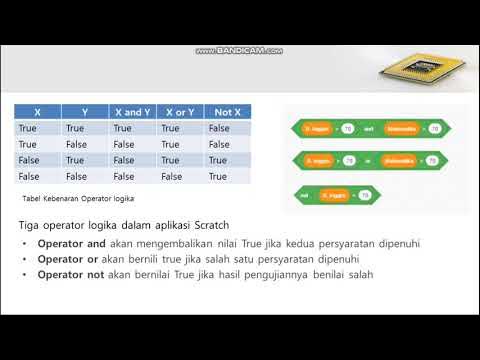VID12-PEMROGRAMAN DASAR : STRUKTUR KONTROL PERCABANGAN C++
Summary
TLDRIn this video, the instructor explains the concept of conditional branching in programming. The focus is on the structure of decision-making, where only the statements that meet certain conditions are executed. Key points include testing conditions to determine whether instructions should be processed, understanding Boolean expressions, and using operands and operators in conditional statements. Examples demonstrate how a program can choose between different outcomes based on user input, such as determining whether a number is positive. The video aims to clarify how conditional logic works in coding for practical applications.
Takeaways
- 😀 Conditional statements (branching) control the flow of a program based on specific conditions being true or false.
- 😀 Only code that meets the true condition gets executed, while other parts are ignored or skipped.
- 😀 Boolean values (true/false) are used to evaluate conditions in conditional statements.
- 😀 A typical conditional structure involves an 'if' statement followed by an 'else' statement to handle both true and false conditions.
- 😀 In a branching structure, the condition must be met for a code block to run; otherwise, it is ignored.
- 😀 For example, a grade check where if the grade is 75 or higher, the student is considered passed, otherwise, no output occurs.
- 😀 If multiple conditions exist, the program will choose the correct block to execute based on which condition evaluates as true.
- 😀 A condition can also involve operators (e.g., +, >, <) which compare operands (e.g., numbers or variables).
- 😀 The program can have different outputs depending on the input (e.g., if a number is positive, a message will be shown; if not, nothing will happen).
- 😀 Understanding how conditions and branches work is essential for controlling program flow and making decisions based on inputs.
- 😀 The speaker encourages using real-world examples like student grades and number checks to understand how branching structures work in practice.
Q & A
What is the purpose of a branching structure in programming?
-A branching structure allows the program to make decisions by executing different blocks of code based on the evaluation of a condition (true or false). It helps in controlling the flow of the program.
How does a branching structure determine which block of code to execute?
-The branching structure evaluates a condition. If the condition is true, the associated block of code is executed. If the condition is false, an alternative block may be executed, or the program may skip the block entirely.
What does it mean for a condition in a branching statement to be boolean?
-A boolean condition is one that evaluates to either true or false. It is a fundamental concept in logic used to guide decisions in branching statements.
Why are conditions in branching statements important in programming?
-Conditions are critical in programming because they control the flow of execution. By checking specific conditions, a program can take different actions based on the input or environment, ensuring dynamic behavior.
What happens if a condition in a branching statement evaluates to false?
-If a condition evaluates to false, the program either skips the associated block of code or executes an alternative block, depending on the structure of the branching (such as an 'else' block).
How are operands and operators used in branching conditions?
-Operands are the values being compared, while operators are the symbols (like >, <, ==) that define the comparison. For example, in the condition 'x > 10', 'x' is the operand and '>' is the operator.
What is an example of a branching statement using a simple condition?
-An example is an 'if' statement that checks if a number is positive. If the number is greater than 0, the program prints 'Positive number'; otherwise, it does nothing.
What does it mean if a number is classified as positive in a program?
-A number is classified as positive in a program if its value is greater than zero. In the provided example, if the input number is greater than 0, it is considered a positive number.
What happens if the user enters a non-positive number, like 0 or a negative number?
-If a non-positive number (like 0 or a negative number) is entered, the program will not display the message indicating it's a positive number, because the condition for a positive number (greater than 0) was not met.
How is the concept of passing or failing a student implemented in the video example?
-In the video example, the student's score is checked to see if it is greater than or equal to 75. If it is, the student passes. If it's below 75, the program does not display a 'pass' message, effectively considering the student as failed.
Outlines

This section is available to paid users only. Please upgrade to access this part.
Upgrade NowMindmap

This section is available to paid users only. Please upgrade to access this part.
Upgrade NowKeywords

This section is available to paid users only. Please upgrade to access this part.
Upgrade NowHighlights

This section is available to paid users only. Please upgrade to access this part.
Upgrade NowTranscripts

This section is available to paid users only. Please upgrade to access this part.
Upgrade NowBrowse More Related Video
5.0 / 5 (0 votes)





